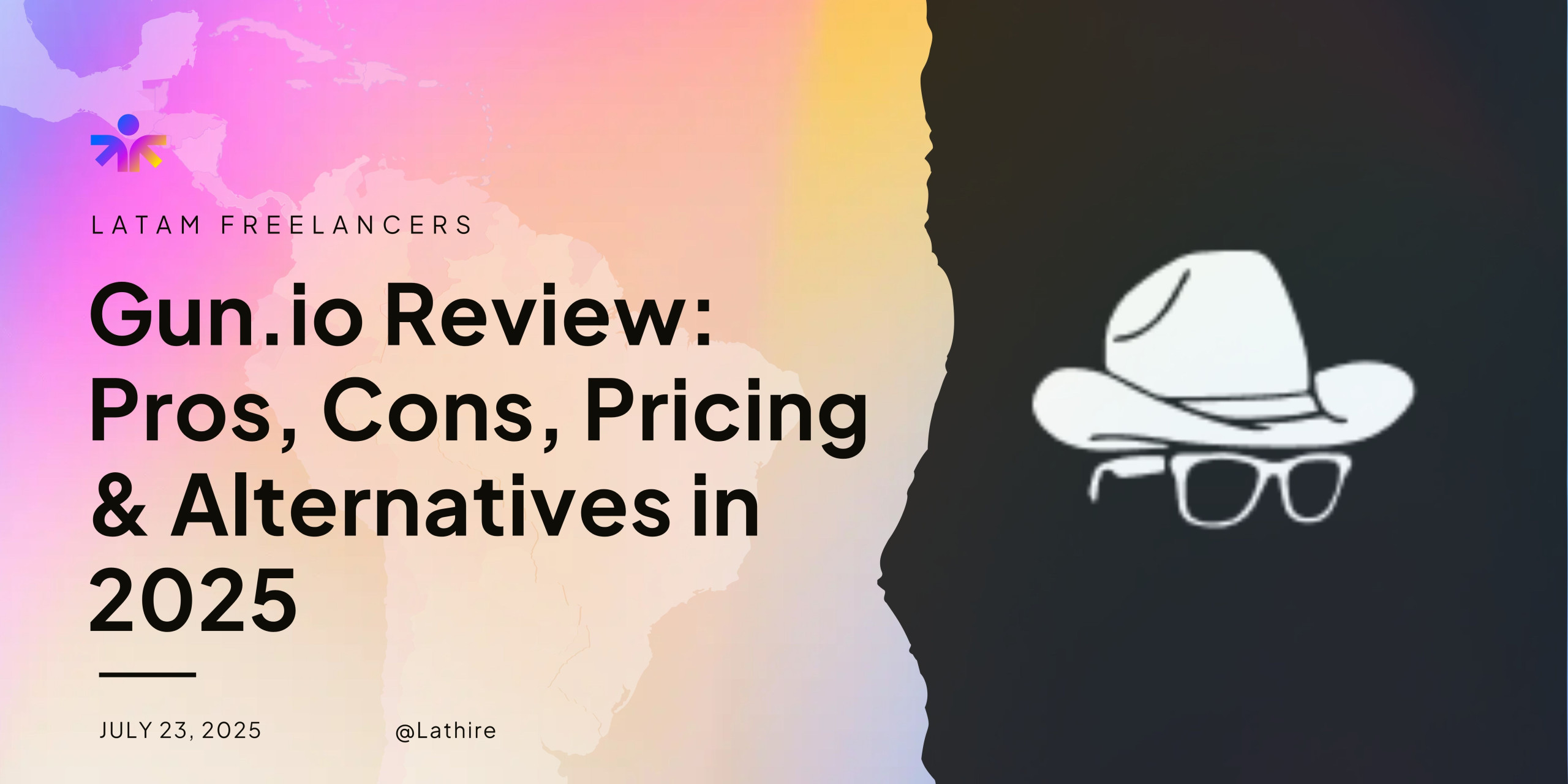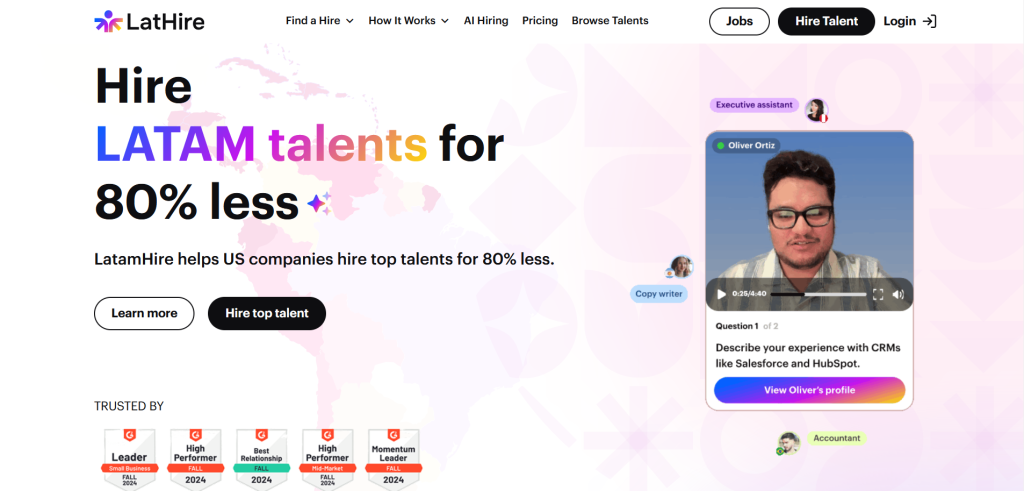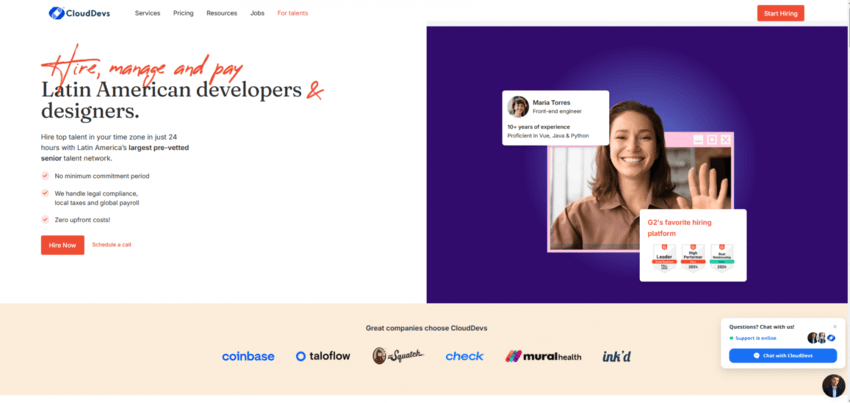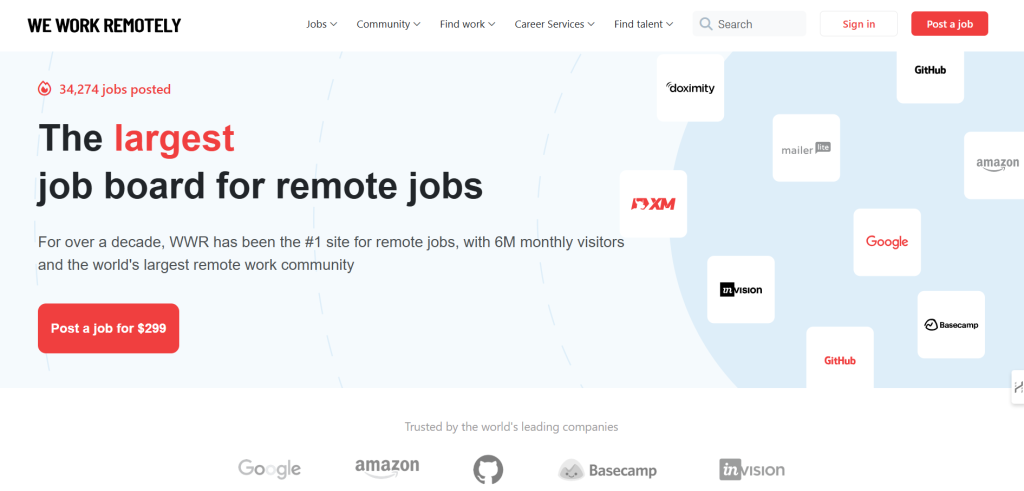
TL;DR: Gun.io is a U.S.-centric developer marketplace with top-tier talent and a 13-day average hire time. Rates range from $100–$200/hr plus a 20% fee for full-time hires. Great quality, but costly. For transparent pricing and LATAM talent, CloudDevs ($45–$75/hr) or LatHire are solid alternatives. Other options: Toptal, Arc.dev, Gigster, Upwork, or remote job boards.

Gun.io is a vetted tech hiring marketplace founded by developers. It connects companies with freelance or full-time software engineers, focusing on experienced talent. Employers start by submitting their job or project scope; Gun.io’s team then screens and matches candidates. Each applicant undergoes automated coding tests and a live technical interview by senior engineers. In practice, Gun.io handles job posting, screening, interviewing, and even contracts/billing on behalf of the client. For example, when you engage Gun.io, they collect your requirements, shortlist qualified developers, organize interviews, and, once you hire someone, manage payroll, paperwork, and legal compliance. This end-to-end support streamlines the process so companies can “start working immediately” with the contractor or new hire.
Gun.io’s focus is on highly experienced developers. The platform claims 70% of placed developers have 10+ years of experience (per some product materials), and only the top ~10% of applicants pass screening. This creates a smaller, close-knit community of elite engineers. A CloudDevs analysis notes Gun.io’s invite-only, handpicked community, which tends to foster strong quality and developer camaraderie. In short, Gun.io is designed for companies that want senior U.S.-based developers without the hassle of vetting each freelancer themselves.
Gun.io’s pricing is all-inclusive but can be significant. Freelancers set their own hourly rates (typically $100–$200/hr), and Gun.io adds its service fee on top. Importantly, employers see the total rate up front, e.g. a $150/hr developer might appear as $150 (developer) + fee (undisclosed) but you never pay extra beyond that. For full-time or long-term hires, Gun.io charges a one-time placement fee equal to 20% of the candidate’s first-year salary. Gun.io emphasizes that there are no hidden costs: you only pay when you hire someone, and all costs are transparent in your contract.
Typical Gun.io engagements are pay-as-you-go: you may work with freelancers hourly (with no minimum commitment) or convert a contractor to full-time via the placement fee. Gun.io also offers optional retainers if you want them to manage a hiring search on your behalf. There is no upfront subscription, only a modest deposit to begin work when using a white-glove service. In practice, companies report signing contracts and starting work relatively quickly: on average 13 days from job request to hire. A dedicated Gun.io project manager actively moves the process along, arranging interviews and communications so clients often have a candidate on board within two weeks.
The core strength of Gun.io is its rigorous vetting process. Every developer applicant goes through multiple stages: an initial algorithmic assessment (coding tests), a detailed resume and work-history review, and a live technical interview by a senior Gun.io engineer. This screening weeds out weaker applicants; only about 10% of initial applicants make it onto Gun.io’s active roster. According to Gun.io and partners, about 100 out of 1,000 developers pass these filters and are presented to clients. This ensures that only highly skilled engineers are recommended.
Once candidates are approved, Gun.io matches them to jobs using both AI tools and its recruiters’ judgment. Clients then interview the shortlisted developers (typically via Zoom, often with a Gun.io rep present). By the time you see a candidate, you can be confident of their basic technical ability and communication skills. Gun.io handles the onboarding paperwork and payment tracking too, so you can simply focus on working with the talent. In summary, Gun.io is akin to a turnkey tech recruiting service, it does all the grunt work of candidate discovery, vetting and administration.
Gun.io generally receives high marks for talent quality and speed. Many reviews highlight that Gun.io “finds freelancers fast” and that its engineers “always deliver results”. A G2 reviewer (co-founder/CTO) said Gun.io took their requirements, interviewed candidates, and presented “the top candidate” quickly, allowing them to “hit the ground running” in under a week. Another startup founder noted that Gun.io developers “go above and beyond,” completing work ahead of schedule and even suggesting improvements, resulting in “phenomenally better” outcomes than prior hires from generic platforms. In short, Gun.io’s vetting pays off in developer reliability and technical expertise.
However, even satisfied clients admit that Gun.io is premium-priced. One CTO quipped, “Talent hired through Gun.io isn’t cheap,” and wished for a bigger budget to use the service more often. Another noted “the price is high compared to hiring full-time, but that’s to be expected with freelance work,” adding that the superior quality “makes the investment in Gun.io worth it”. These comments underscore that while quality is excellent, Gun.io’s rates and fees are higher than those on general marketplaces. A few users also warn of occasional scheduling delays: because many Gun.io developers are in-demand, “developers can get overbooked with projects and things get slightly delayed,” though the developers/Gun.io team “do their best to make things right” when it happens.
Pros of Gun.io:
Cons of Gun.io:
Overall, Gun.io is a solid choice if you need top-tier developers and want the convenience of handled hiring, and you have the budget to pay for that level of service. But if any of the cons above are deal-breakers, it’s worth exploring alternatives below.
If Gun.io doesn’t perfectly fit your needs (e.g. you want broader talent pools or lower costs), there are several other platforms to consider in 2025. Each has its niche:

What it is: LatHire (LATAM.Hire) is a full-service talent marketplace headquartered in the U.S., specializing in Latin American hires across tech and non-tech roles. Its platform boasts an 800,000+ member network of LatAm professionals. LatHire uses AI-driven matching and human recruiters. It offers a white-glove service (account manager, HR/payroll handling) and claims hires in as little as 24 hours due to its pre-vetted talent.
Pricing/Terms: LatHire emphasizes cost savings, on average clients save 80% versus local U.S. hires. The standard “Monthly Staffing” plan is $1,999 per month per hire (all-in, no additional fees). This covers salary, benefits and all compliance. By comparison, a U.S. salary of ~$78k vs. a LatHire budget of ~$21k (incl. taxes) shows an 80% saving. Many LatHire clients fill roles for under $2,000/month including payroll. There is no placement deposit; you pay monthly until you replace or stop the hire. LatHire also offers one-time direct hire buyouts for 48-hour placements (no hidden fees).
Why consider LatHire as a Gun.io Alternative: It’s ideal if you want a broader talent pool (tech and non-tech) from Latin America with end-to-end support. For startups or small teams seeking quick, budget-friendly hires, LatHire stands out. The combination of AI vetting and extensive in-house HR/compliance (they handle cross-border payroll, tax, benefits, etc.) reduces admin overhead. Clients report that LatHire’s curated pool lets them “hire in 24 hours” and save about 80% on total compensation costs. In short, if you’re open to LatAm candidates and want managed hiring, LatHire often delivers faster matches and lower all-in costs than Gun.io.
LatHire vs. Gun.io: LatHire vs Gun.io differs in focus and cost. LatHire is general-purpose (tech & non-tech) and location-specific (Latin America), whereas Gun.io is tech-only with U.S. devs. LatHire’s model offers fixed monthly rates with all services bundled, compared to Gun.io’s variable hourly/project rates. LatHire’s tagline is “hire in 24h, save 80%”, while Gun.io averages 13 days and higher costs. Also, LatHire uses AI-enhanced vetting and lets you directly browse candidates via an app, whereas Gun.io relies on recruiters to recommend shortlist. The tradeoff: Gun.io’s vetting is very hands-on for dev roles, while LatHire balances automation with scale.

What it is: CloudDevs is a popular talent marketplace focused on Latin American software engineers and designers. It bills itself as the “largest pre-vetted talent platform in LATAM” with hundreds of thousands of members. Founded to give U.S. companies access to nearshore talent, CloudDevs assigns a dedicated recruiter and offers 24–48 hour matching from its pool. It handles all payroll, taxes and legal compliance automatically, you simply pay for hours worked.
Pricing/Terms: CloudDevs advertises zero upfront fees for matching. Instead of placement fees, there’s a $500 refundable deposit for the risk-free trial (credited to your first invoice). Hourly rates for senior Latin American developers are roughly $45–$75/hr. (A recent CloudDevs FAQ says $35–$80/hr depending on seniority.) This is roughly 40–60% less than comparable U.S. rates. All contracts are weekly/monthly rolling with no minimum commitment. If a developer leaves in the first 7 days, CloudDevs promises a replacement or refund.
How it works: You tell CloudDevs your project specs, and within a day or two they present vetted candidates. Their vetting covers communication, skills tests and live coding challenges, but it’s generally less stringent than Gun.io’s. CloudDevs emphasizes fast matching, typically a developer is “assigned within 24–48 hours”. They boast “over 400,000 Latin American developers on its platform” (according to CloudDevs) and claim a 60% cost savings on salaries vs U.S. rates.
Why consider CloudDevs as a Gun.io Alternative: For companies specifically targeting Latin American devs, CloudDevs is often the go-to. It offers quick turnaround (as fast as a day) and very competitive rates. The all-inclusive billing and compliance are handled for you, making cross-border hiring seamless. If you need a senior backend engineer or React developer who overlaps your timezone and costs substantially less, CloudDevs typically outshines Gun.io on price and speed. (Some users note minor downsides like occasional scheduling hiccups, but overall reviews are strong.)
CloudDevs vs. Gun.io: In head-to-head terms, CloudDevs offers Latin America–based talent at lower rates vs Gun.io’s U.S. developers. For example, CloudDevs’ $45–$75/hr vs Gun.io’s $100–$200/hr range. CloudDevs guarantees talent matching in about 24–48 hours, whereas Gun.io averages ~13 days. CloudDevs handles payroll & taxes automatically, unlike Gun.io which routes pay through the contractor. On the flip side, Gun.io’s devs are U.S.-based and its vetting is exceptionally rigorous for top-shelf skill. Choose CloudDevs if you want affordable, nearshore devs quickly; choose Gun.io if you strictly need U.S. talent and hands-on recruiter support.

What it is: Gigster is not a gig marketplace but a full-service software development agency. It assembles dedicated teams (developers, designers, PMs) to build entire projects end-to-end. Gigster’s clients are typically well-funded or enterprise companies with large budgets and complex needs. You submit a detailed project spec, and Gigster’s AI+analytics give you a fixed project quote and roadmap. They then quickly form a team of ~5–20 top engineers, designers and managers to deliver the project, claiming “guaranteed success” under a managed engagement.
Pricing/Terms: Gigster is much higher-end. There is a minimum project size of roughly $52,000, reflecting its focus on enterprise work. Hourly rates for Gigster talent average about $100–$149/hr (and can exceed $150/hr). Gigster invoices typically cover multi-month contracts; clients often spend tens or hundreds of thousands in total. Because Gigster itself employs (or contracts) the team, you don’t pay hourly directly to individual freelancers. Instead, you pay Gigster the agreed project or hourly price, and Gigster pays the talent. They also include project managers and QA as needed.
Why consider Gigster as a Gun.io Alternative: Use Gigster when you need a turnkey solution for a big initiative. For example, building a custom mobile app, AI system, or large web platform. Gigster’s strength is rapid team assembly (they claim 50,000 vetted experts globally) and full project management (PMs, sprint planning, QA, etc.). If your priority is “we tell Gigster the goal, and they deliver working software,” Gigster can be compelling. It abstracts away almost all technical hiring and oversight. The downside is cost: Gigster engagements often start at ~$50K and easily run higher. But you trade that cost for convenience and top-tier talent managed for you.
Gigster vs. Gun.io: Gigster differs fundamentally. Gun.io provides individual hires (freelancers or contract engineers) that you manage. Gigster provides full teams and project leadership. Budget-wise, Gigster usually demands a large up-front engagement (often $50K+), whereas Gun.io can work on smaller retainer or hourly basis. If you want control to hire and manage a freelancer, Gun.io fits; if you want Gigster to own the project delivery end-to-end, Gigster is the choice. Also, Gigster’s matching process is quick and uses AI, but it’s aimed at broad scopes, not just coding gigs. In short: Gun.io = staffed engineering, Gigster = outsourced product build.
What it is: Toptal is a well-known premium freelance platform that also claims only the top 3% of applicants are accepted. It started with developers but now covers designers, finance experts, product managers, etc. Toptal is known for a very rigorous vetting process (multi-stage tests, trial projects, ongoing feedback) and a focus on Fortune-500/enterprise clients. It markets itself as “the elitenet” of freelancing.
Pricing/Terms: Toptal is very expensive. Rates typically run $65–$200+ per hour depending on talent, with many falling in the $100–$150 range. There are also significant fees. Notably, Toptal requires a $500 refundable deposit to begin a search. This deposit is applied to your first payment or returned if you end the search after a short trial (usually 2 weeks). In practice, that means you need commitment upfront. Some reports say Toptal’s effective markup can be 30–50% over the developer’s base rate (though exact numbers are opaque). Toptal does not publish a flat fee schedule; costs are custom-quoted.
Process: You define your needs to a Toptal rep, who then (usually within 48 hours) presents 1–3 candidates to interview. Toptal offers a two-week risk-free trial; if you’re not satisfied, you can end engagement and get the deposit back. The vetting is intensive, often a 5-step screening (language, technical interviews, test projects, etc.), so the quality of a Toptal developer is generally excellent.
Why consider Toptal as a Gun.io Alternative: Choose Toptal if you demand top-1% global talent and need them quickly, and you can afford enterprise pricing. Toptal shines for mission-critical or strategic hires (especially in tech, design, or finance) where the hiring risk must be minimized. Their developers often have backgrounds at big firms. If a startup can stomach the fees and deposit, Toptal offers fast matching (sometimes <1 week) and a trial that mitigates risk.
Toptal vs. Gun.io: Both are high-end, but differences matter. Toptal is global and truly elite (“top 3% worldwide”), whereas Gun.io is U.S.-centric and slightly broader. Toptal requires a $500 deposit and often a monthly minimum spend; Gun.io has no deposit but has the 20% placement fee for full-time hires. In speed, Toptal claims ~48-hour match time (with trial) vs Gun.io’s ~13 days. In cost, Toptal’s effective hourly (after fees) is comparable or higher than Gun.io’s top end. Both have intense vetting. If you want the very fastest access to vetted senior talent with guaranteed trial, Toptal is a contender; if you prefer a pay-as-you-go freelancer with U.S. focus, Gun.io is simpler.

What it is: Arc.dev (formerly CodementorX) is a marketplace for remote developers (and some designers) of all levels. It brands itself with a “top 2%” claim and uses an AI-driven matching called “HireAI.” Arc supports both contractors and full-time placements. It’s popular with startups and smaller companies that need vetted help quickly.
Pricing/Terms: Arc charges freelancers’ hourly rates directly, with a 20% placement fee on full-time salaries. Contract rates are typically $60–$110/hr for skilled developers (evenly distributed globally). To start hiring freelancers, Arc requires a $300 refundable deposit (like Toptal’s deposit) which is applied to the first invoice. This deposit is refunded after the hire begins. There are no other platform fees beyond the commission built into developer rates. Arc claims no long-term commitments, you can stop the contract at any time.
How it works: You submit a job to Arc, and the “HireAI” engine instantly shows you matches from its 450,000+ global pool. For contractor hires, Arc promises to find candidates “in 72 hours” on average. For full-time roles, it aims for ~14 days. Arc vets candidates via resume review, code challenges, interviews and background checks (much like Gun.io). They take care of invoicing and compliance through a back-end EOR. Many Arc clients report significant cost savings, Arc advertises up to 58% lower costs versus traditional U.S. hiring.
Why consider Arc.dev as a Gun.io Alternative: Arc is a hybrid: you get Gun.io–style vetting and matching, but often at lower rates and more global reach. The key selling points are speed and transparency: you can literally browse the system 24/7 and see candidate profiles and pricing instantly. Arc’s deposit is modest ($300), and they emphasize “pay only if satisfied.” If you want a vetted developer quickly but at mid-level pricing, Arc is a good middle ground. For example, its $60–$80/hr mid-tier rates can be far below Gun.io’s $100+ rates, yet the talent is still thoroughly screened.
Arc.dev vs. Gun.io: Arc and Gun.io share many features (rigorous vetting, US startup clients, etc.) but have distinctions. Arc’s network is truly global (190+ countries) and AI-driven, whereas Gun.io’s is U.S.-centric and recruiter-driven. Arc demands a $300 deposit for freelancers; Gun.io does not. Arc’s rates tend to run lower (60–$110/hr vs $100–$200/hr). In speed, Arc boasts 72-hour matches, slightly quicker on paper than Gun.io’s 13 days. If you want flexibility and access to global talent at modest rates, Arc could beat Gun.io; but if you need exclusively U.S. devs and are okay with slower matching, Gun.io might feel more personal.

What it is: Upwork is the largest global freelance marketplace, open to professionals of every skill. Unlike specialized sites, Upwork has virtually no entry vetting. Employers post a job, freelancers apply/bid, and you choose from applicants. It covers all roles: from developers to marketers.
Pricing/Terms: Posting on Upwork is free under the basic plan. When you hire a freelancer, Upwork charges a 5% client fee on every payment plus a flat $4.95 payment initiation fee per new freelancer engagement. (There are higher-tier plans for added features, but basic clients pay 5%.) Freelancers themselves pay 5–20% of their earnings to Upwork, which can affect their rates. In practice, you control the pay: you propose a budget or hourly rate, freelancers bid within that. Hourly rates on Upwork vary widely: for example, you might find a mid-level developer at $30/hr or a senior one at $80/hr, depending on talent and region.
How it works: On Upwork, you do the matching. Post your project with requirements and budget, then sift through dozens (even hundreds) of proposals. You review freelancer profiles, work history, reviews and perhaps test jobs. Upwork does offer AI-based job matching and some skill tests, but it does not pre-vet applicants. The hiring process can be instant (you can interview and hire within a day if needed). You also manage contracts and payments through Upwork’s escrow system.
Why consider Upwork as a Gun.io Alternative: Upwork is ideal for general-purpose or short-term needs, especially if budget is the priority. You get an enormous talent pool (18+ million freelancers globally), so you can typically find someone for $20–$50/hr on simpler tasks. It’s very scalable and quick, provided you invest time in vetting applicants yourself. There’s no large deposit or placement fee; you only pay the 5% service fee. Compared to Gun.io, Upwork is the DIY approach: lower cost but higher effort to find the right candidate.
Upwork vs. Gun.io: The trade-offs are clear. Upwork’s biggest advantage is flexibility: post anything, from short tasks to ongoing contracts, and set your price. Gun.io’s advantage is quality assurance and full support. If you have the ability to thoroughly screen candidates, Upwork can be extremely cost-effective (since you set freelancer rates). However, if you need guaranteed vetting and hand-holding, Gun.io is safer. In summary, use Upwork for rapid, broad hiring (many bids, low fees), and Gun.io for fewer candidates but premium, done-for-you hiring.

What it is: We Work Remotely (WWR) is a job board, not a talent matchmaker. It’s the world’s largest site for remote job postings, with millions of monthly visitors and thousands of active developer/design jobs. WWR does not match you to candidates, instead, you post a job ad and qualified candidates apply through your contact.
Pricing/Terms: Posting a developer job on WWR costs $299 per job for 30 days(with optional paid upgrades). There is no subscription or commission. You simply pay a one-time fee to list. Because there are no application caps, you often get dozens or hundreds of applicants for developer roles. WWR also offers bundle discounts if you post multiple jobs.
How it works: You craft your job description on WWR’s platform, pay the posting fee, and wait. WWR then publishes it to its site and partner networks (Google Jobs, etc.). Candidates see your listing and apply via email or your company’s process. You then sift through resumes and conduct interviews on your own. WWR even has a $199 “filtering service” (for an extra fee) where they pre-screen applicants for you.
Why consider WWR as a Gun.io Alternative: Use We Work Remotely if you want maximum visibility for a technical role and don’t mind doing the recruiting yourself. It’s excellent for reaching seasoned remote developers: many U.S. startups have success hiring through WWR. Since you pay a flat $299, WWR can be cheaper than any talent marketplace if you’re willing to put in the effort. The risk is that you must vet candidates yourself and handle all communications, there’s no hand-holding. But for startup founders or HR teams casting a wide net, WWR’s high traffic can yield strong applicants quickly.
WWR vs. Gun.io: WWR is fundamentally different. It’s self-serve: you pay once to post and then do all vetting. Gun.io is full-service: you pay per hire for a managed process. Cost-wise, WWR’s $299 flat fee can be much lower than Gun.io’s total charges if you hire multiple roles. But WWR offers no screening, you might get unqualified applicants. Gun.io guarantees vetted talent at a premium. So pick WWR if you have internal HR bandwidth and prefer a simple job ad; pick Gun.io if you want a dedicated recruiter and guaranteed candidates.
The right choice depends on your priorities:
In summary, Gun.io remains a solid all-around choice for vetted U.S. developers with minimal recruiting effort. But in 2025 there are many strong alternatives:
Assess your project needs, budget and timeline. If you value speed and vetted LatAm developers, LatHire or CloudDevs often lead. If you simply want vetted U.S. devs and are okay paying more, Gun.io is reliable. For the very elite or large scale, Toptal/Gigster are top options. And for maximum flexibility or cost-control, Upwork/WWR can’t be beat, as long as you handle the vetting. Each platform has its niche; choose the one that aligns with your requirements in 2025.
